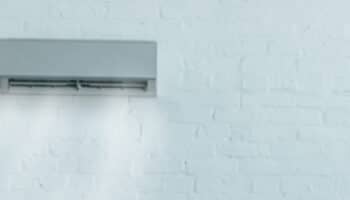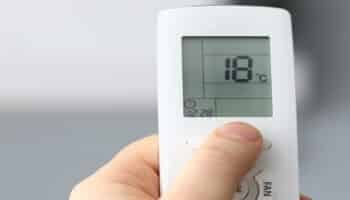Running an air conditioner isn’t cheap – it can cost up to 27% of our total energy bills.
We all want to make sure we’re getting the most out of our air conditioners, but people often use them inefficiently – which can cost more in energy and in maintenance. One common misconception is that you should leave an air conditioner running when you’re out during the day.
There’s a lot of opposing advice on this topic, so I dove into researching it. In preparing this article I’ve contacted HVAC experts, gone through scientific studies, and spent over 10 hours researching this topic.
The conclusion I found – that you shouldn’t leave your AC on – disagrees with much of the advice that large media sites are giving out.
If this is correct, then thousands of homeowners are costing themselves money in both energy bills and air conditioner maintenance.
Want to make sure you’re not wasting money? Then let’s dive in.
The Quick Answer: Should You Leave Your AC Running When You’re Out?
I know this is the internet, and everyone’s in a rush. So here’s the quick answer.
In short, you shouldn’t leave your AC running when you’re out. It will almost always cost you more (in bills and in maintenance) to leave your air conditioner running than to set back your thermostat (e.g. turn it back up from say 68 to 78).
This is explained fully below, but basically your air conditioner is most efficient when cooling a hot room. You will almost always save more energy by setting back your thermostat than letting your air conditioner maintain a temperature. There are some exceptions – covered later.
Now, I know this seems counterintuitive. Surely you need less power to maintain a cool temperature, than using full power to tackle a hot room, right? So what gives?
I had this same thought when I started looking into this topic. It took a detailed explanation by various HVAC experts (who ALL agreed on this answer) for me to understand.
Let’s dive into the details.
Note – the research below is for standard air conditioners. If you own a 2-Stage or an Inverter AC, these are covered afterwards.
Why It’s Worse To Leave Your Air Conditioner On
When your room is roasting hot, your air conditioner works like crazy to get it down to a cool temperature.
Once the room is cool, the air conditioner turns off and on again occasionally to keep the temperature low.
So what gives? Isn’t the second mode using way less energy?
To understand what’s happening, we need to understand air conditioner efficiency.
When An Air Conditioner Is Most Efficient
The graph below is from a research study looking into air conditioner efficiency:
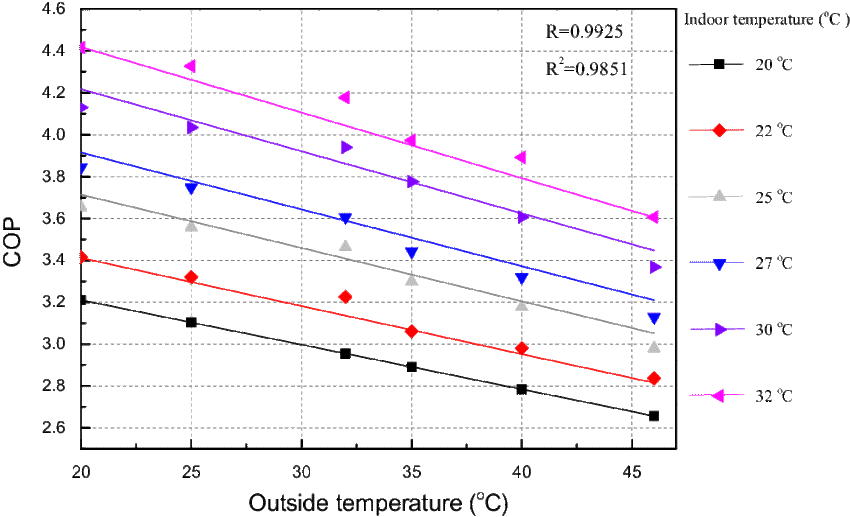
COP is air conditioning efficiency – it’s [BTU’s Moved / Watts]. In other words, the change in heat divided by the energy used.
As you can see, the higher the indoor temperature, the more efficient the air conditioner is. As with the cooler outside temperatures.
In short, air conditioners are most efficient when the room they are cooling is hot.
“That’s great”, I hear you say, “but doesn’t it take less energy to maintain a temperature – even if it’s less efficient?”
That was my argument! It’s the same aspect I had trouble understanding. So let me cover how the HVAC pros explained it.
Cooling vs Maintaining
My biggest struggle to understand all this was a simple scenario comparison. Assuming all other factors are equal, and the outside temperature stays the same:
- Scenario A: You have a room at 68F, and maintain that temperature
- Scenario B: You have a room at 90F, cool it to 68F, then maintain that temperature
Surely Scenario B takes more energy, right?
It does. But that’s not the end of it.
The reason why Scenario A is worse is that it can only happen in theory. For the same room to be so much cooler, one of two things must have happened.
- It’s morning and your AC turned on as soon as the temperature hit 68F.
- It’s daytime and you’ve had the AC on all day.
Those are the only 2 ways in which Scenario A can happen. Both of them cost more in energy than the small saving made in the bolded comparison above.
In Summary:
While you CAN save a little bit of energy purely ‘maintaining temperature’ vs ‘cooling and maintaining’, it’s always a loss because to be maintaining you must have cooled the room previously. You either have had to run the AC from morning (costing more energy), OR already have it running in the afternoon (costing more energy).
Whatever the option, you’re almost always better setting the thermostat back when you’re out of the house.
Proof Through Research
One of the reasons I dove so deep into this topic is that there’s so many contrasting opinions.
However, Powerely.com did a study into this and gathered data on the energy savings when setting back thermostats for 8 hours a day (i.e. when out for work).
The data speaks for itself:
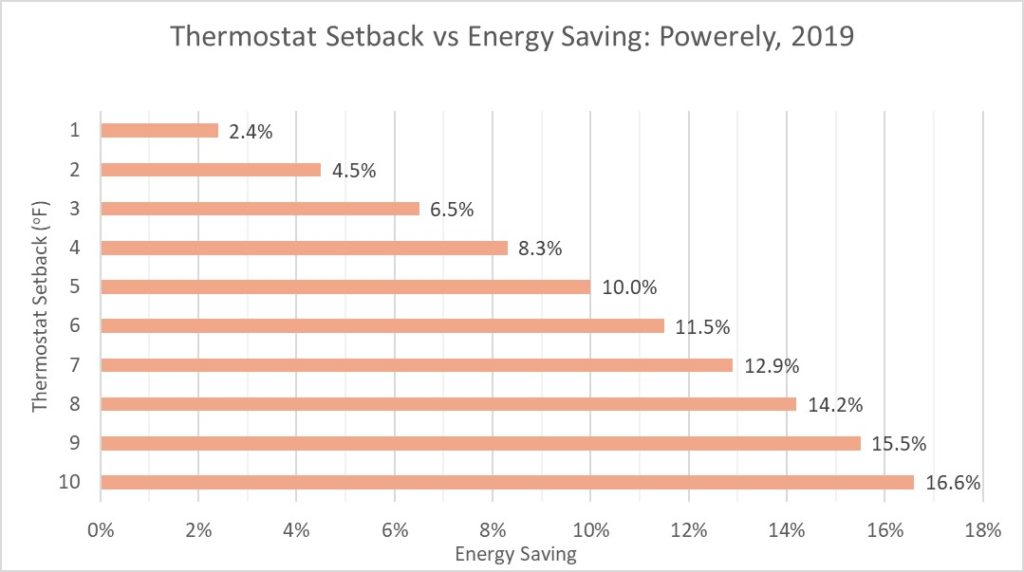
However, the above study is only true for an 8-hour time window. What about shorter setback periods? While we don’t have data – we can come to a conclusion.
Since we know that energy is saved over an 8-hour setback period, we can expect that this will be similar in shorter periods. While there MAY be a window so short that temperature maintenance is better, any energy savings will likely be tiny.
Plus, even if you’re only expecting to be out for a short time – you never know what life could throw at you. We all know that a 5-minute trip can turn into a much longer outing, so it’s always a safe-bet to set back your thermostat every time.
When Maintenance & Setbacks Are Most Effective
Up until this point, each argument I’ve made has been under the assumption that ‘all other factors remain the same’.
As we all know, though, everything is constantly changing. Especially when it comes to the outside temperature!
Understanding the factors that affect your AC’s power usage is key to making sure you’re running yours efficiently. Here they are.
Outside Temperature
The most important factor is whether it’s getting hotter or cooler outside.
Since we know that air conditioners are most efficient when it’s hotter inside and cooler outside (see the first chart), we know that efficiency must be worse in the morning and best in the afternoon.
If your AC is on while things are getting hotter, maintenance is a good idea; the air conditioner would have a greater amount to cool once you turn it back on.
However, if the outside temperature is getting cooler (i.e. late afternoon), it’s DEFINITELY a bad idea to keep your AC running when you’re out the house – because the later your switch the AC back to full power, the less it’s going to have to cool.
In other words, it’s best to maintain a cool temperature in the morning (as the outside temperature rises) or to set back and cool a temperature in the afternoon (as the outside temperature falls).
Time
As we saw with the Powerley study above, the longer a setback period, the more energy you save. However, when it comes to short periods (<1hour), just maintaining a temperature CAN be equal or better.
I’d only consider not setting back a thermostat if you’re popping out for under 20 minutes. Remember you may end up being out for longer than you think.
Insulation
The last factor is your home’s insulation. Having great insulation means it’s a lot easier for your air conditioner to maintain a temperature.
Likewise, if you have bad insulation, your AC is going to need to work incredibly hard to fight off the heat invading your home.
The worse your home’s insulation, the quicker you should jump to setting back your AC when out.
Air Conditioner Types
The vast majority of us own standard 1-stage air conditioners.
Simply put, these AC’s are either running at 100% power or 0%. This is the type that has an obvious compressor ‘clunk’ which then runs for a while before shutting off again. While it’s the most basic type, they also work just fine.
The second type of air conditioner is a 2-stage model. These have one added power setting – around 60-70% – which is meant for efficient temperature maintenance. 2-Stage Air Conditioners are naturally better at energy saving as they don’t use full power when they don’t need it. They’ll cycle on and off much less, instead providing a more energy saving low or ‘eco’ mode.
Finally, we have inverter air conditioners. These are a mini-revolution – they can operate at anywhere between 0% and 100% power. That means the provide only the power you need to cool then maintain a temperature.
The Only Time You Should Leave An Air Conditioner Running (24/7)
Inverter air conditioners are a game changer when it comes to temperature maintenance.
In my research, I spoke to a homeowner that runs his inverter air conditioners constantly. Yes, constantly. This doesn’t mean they’re using maximum power all day – they’re often on super low, giving just a little bit of cooling throughout the night and morning. Then they ramp up when needed in the afternoon.
Below is a chart of his inverter air conditioner’s power usage.
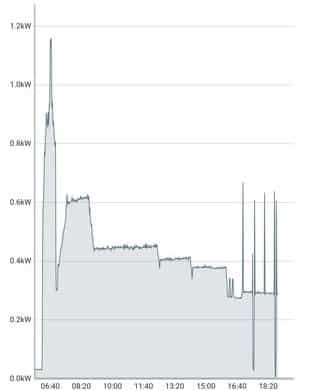
This is very different to a traditional air conditioner, which cycles at high power (typically 1.5kW or more) to keep a temperature maintained.
Thanks to this adaptive power, inverter air conditioners have been found to save up to 35% energy compared to single stage models.
The OTHER Cost Of Running An Air Conditioner
Throughout all this research, we’ve been focused on saving energy. While it’s nice to limit our impact on the environment, let’s be honest. The main reason is because we hate high energy bills!
We need to consider the other cost here. Maintenance.
Even if setting back an AC was equal or below the energy savings of maintaining a temperature, the wear and tear we impose on an air conditioner is never good.
Leaving your air conditioner running will increase the maintenance costs of your system. Especially given the compressor will be constantly cycling on and off all day. For that reason, you should (again) lean towards setting back your thermostat whenever you leave the house.
Air Conditioner Energy Saving Tips
Just to round out this article, I thought I could share a few tips on other ways to save energy with your air conditioner:
- Experiment with Temperatures. AC’s have to work harder and harder to cool each degree. It takes more than double the energy to cool 10 degrees instead of 5 degrees. See if you’re still cool after raising the thermostat a degree or two.
- Keep it out of the Sun. Putting your AC in direct sunlight and asking it to cool is plain appliance torture. Where possible, keep portable units in the shade, and try to protect window units from direct sunlight.
- Change Your Filters! This is super easy – a case of taking off the lid and cleaning/replacing filters. Check your manual for model-specific instructions.
- Clean Coils. At least once a year, take a light comb to the back of the air conditioner and lightly brush downwards to clear any dust and buildup from the cooling coils.
- Give it Room. Every air conditioner needs room to work, otherwise the cold air ends up clogged in one corner. Don’t block an air conditioner with furniture, or have it right up against a wall.
- Keep Your House Cool. There’s a TON of other ways you can use to keep your home cooler than just cranking up the AC. We’ve got a whopping list of 73 tips you can use to stay cool without using an air conditioner.
Conclusion
We’ve all been caught off-guard by air conditioning bills, so it’s important to make the most out of our cooling systems.
I hope this walkthrough has helped you understand the impact of leaving an air conditioner running vs setting back your air conditioner. Even if I just help a few people save on their energy bills each month, all this research will have been worth it!
If you have any questions, please do leave a comment or send me an e-mail. I want to make this guide as clear and helpful as possible.
If this has helped you, check out our related articles below for more content on getting the most out of your air conditioners.
Thanks for reading, and have a great day!
Craig





